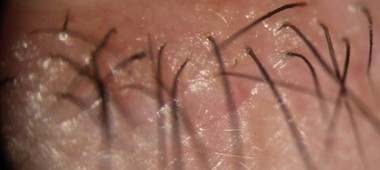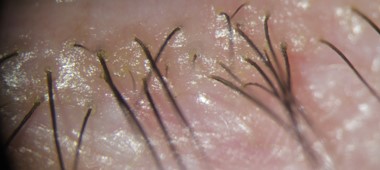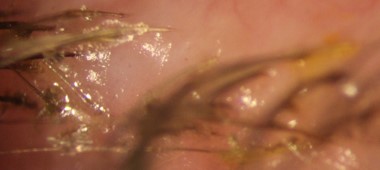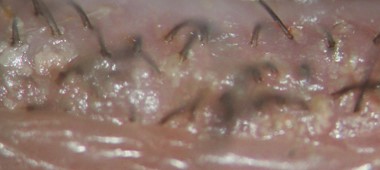What is Blepharitis?
Blepharitis is a chronic, inflammatory disease of the eyelids caused by an overgrowth of normal bacteria living along the lid and the base of the eyelashes. Anyone can get blepharitis at any age, but the prevalence increases with age; as we get older, we make fewer natural antibodies in our tears.
This overgrowth of bacteria produces a biofilm that traps scurf and debris along the eyelashes and harbors bacterial exotoxins along the lid margin. These exotoxins penetrate the eyelid tissue causing low-grade inflammation which adversely affects the tear glands, reducing tear production. Fewer tears containing fewer antibodies allow even more bacteria to accumulate and a vicious cycle is established, leading to chronic irritation and dry eye.
Since the eyelids are difficult to clean, this overgrowth of bacteria, biofilm, scurf and debris can accumulate over many years and the exotoxin-induced inflammation can cause significant damage to the eyelid and tear glands.
Progressive Stages of Blepharitis
- Stage 1 Inflammation of lid margin with minimal to no scurf
- Inflammation with mild scurf, lash follicle swelling
- Inflammation with moderate scurf, lash follicle swelling, early lash misdirection
- Inflammation with heavy scurf, lash follicle swelling, lash misdirection and ingrown lashes
Relief for Blepharitis
Now, thanks to BlephEx®, Dr. David R. Pernelli, MD and Dr. Terrance K. Heacox, Jr., OD can precisely and safely cleanse and exfoliate your eyelids and lashes, which should almost immediately improve your symptoms. More importantly, by completely removing the exotoxin-laden biofilm along the lid margin, you avoid long-term inflammatory damage to your tear glands, helping treat or prevent chronic dry eye syndrome.

How BlephEx® Works
BlephEx® is a painless in-office procedure performed by your eye care professional or trained technician. A revolutionary new patented BlephEx® handpiece is used to very precisely and carefully spin a medical grade micro-sponge along the edge of your eyelids and lashes, removing scurf and debris and exfoliating your eyelids.
The patented micro-sponge is disposable. For optimal cleaning and exfoliating, a fresh, clean one is used for each individual eyelid. The eyes are rinsed well afterwards.
The procedure lasts about 6 -8 minutes and is well tolerated. Most patients simply report a tickling sensation. A numbing drop is usually placed in each eye prior to treatment for increased comfort.
After the procedure, the patient is instructed on how to maintain their clean eyelids with regular nightly lid hygiene. Since home treatments are only semi-effective, the procedure is typically repeated at 4-6 month intervals.
Am I a Candidate for BlephEx®?
If you suffer from one or more of the following symptoms, you may be suffering from blepharitis:
- Itching or scratchy eyes
- Foreign body sensation
- Tearing
- Crusting
- Redness/Inflammation
- Mattering
- Dry eyes
- Eye rubbing
Blepharitis can only be diagnosed by an ophthalmologist or optometric physician. Make sure to let your doctor know of your eye symptoms and inquire about BlephEx®, the latest in eye care technology for prevention of lid disease.
There are several conditions which may affect the severity of blepharitis such as dry eye disease, allergies, seborrheic dermatitis, rosacea, age, contact lens wear, poor immune status, rheumatoid arthritis, Sjogren’s disease and androgen deficiency.
Potential Eyelid Diseases Due to Blepharitis
If left untreated, blepharitis can lead directly or indirectly to a number of eyelid diseases, such as:
Contact Lens Intolerance: contact lens wearers are more prone to developing biofilms and subsequent blepharitis/dry eye. Bacteria can adhere more easily to a contact lens than to human tissue, allowing them to increase their numbers earlier in life. This increase in bacteria leads to early formation of biofilms, exotoxins and inflammation which sensitizes these eyes to reject the contact lens. Treatment every 6 months can help prevent this from occurring.
ipt>
Dry Eye Syndrome: due to inflammatory down regulation of tear glands in the eyelids and swelling with subsequent occlusion of tear excretory ducts. Treated with numerous artificial tears, cyclosporine drops, punctal plugs, night-time moisture chamber googles or bedtime lubricating ointments.
Chalazions (styes): blockage of meibomian excretory ducts causing painful swelling of meibomian gland with leakage of highly inflammatory oil components into surrounding tissue. Treated with hot compresses, lid scrubs or surgery.
Trichiasis: an inward turning of the lashes so that they abrade the corneal surface causing irritation, tearing, poor vision and occasionally corneal scarring. It is caused by acute and chronic inflammation of the lid margin which disrupts the normal intra-lid anatomy surrounding the lash follicles. Treatment is epilation of the lashes, either mechanical or by using electrolysis.





